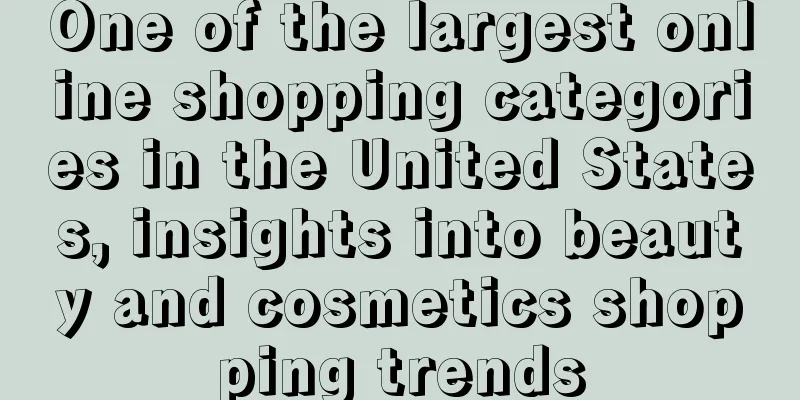One of the largest online shopping categories in the United States, insights into beauty and cosmetics shopping trends

|
It is learned that in March this year, DigitalCommerce360 and BizrateInsights conducted a survey of 1,053 online shoppers in the United States and found that 70% of them buy beauty and cosmetics products online at least once a month. As a category with high repurchase attributes, beauty and cosmetics have huge room for growth in the US e-commerce market.
The survey also analyzed the preferences, channels and influencing factors of American consumers in purchasing beauty and cosmetics, and deeply interpreted the consumption trends of Americans. The analysis showed that among those who shop online for beauty and cosmetics at least once a month, 31% buy online at least weekly, and a small number even buy online every day. Main channels for online shopping of beauty products
According to the survey, American consumers are relatively scattered in their online shopping channels for beauty and cosmetics products, with comprehensive e-commerce platforms, vertical retailers, department stores and social media platforms all occupying a certain market share. Among them, Amazon ranks first in the beauty and cosmetics e-commerce market with 59% of online shoppers, followed by large retailers such as Target and Walmart, where 52% of people buy.
Vertical specialty retailers also performed strongly, with 29% of respondents saying they would buy from this channel, as these vertical categories often also work with large retailers, and 27% also buy these traditional brands' products from large retailers.
The purchasing population of DTC brands accounts for 21%, among which the penetration rate of digital native vertically integrated brands (DNVBs) is 12%, which means that in the beauty and cosmetics category, DTC brands are also popular among Americans.
In addition, the number of people purchasing beauty and cosmetics products through social media platforms is also increasing, with 15% of respondents saying they have purchased through this channel. The audience of this channel is expected to continue to grow in the next few years.
The purchasing power of offline channels cannot be ignored either. 47% of respondents said they would like to try out products in person in offline stores, and about 20% also like to go to specialty counters to consult counter staff.
Decision-making factors for online beauty and cosmetics shopping
The survey shows that no matter which channel they ultimately purchase through, Americans prefer to research products and compare prices online before buying beauty and cosmetics. 30% of people learn about new brands and products online and then buy them online, while 22% buy them in physical stores.
Based on the attributes of the beauty category, most consumers have high brand loyalty and purchase frequently. In terms of factors that influence buyers' purchasing decisions, the completeness of the information provided on the product details page is crucial, including product details (56%), product inventory (55%), product ingredients (48%), and product images (25%). As American consumers pay more and more attention to cost-effectiveness, product promotions and discounts are also very important. Tools to help consumers make decisions are also playing an increasingly important role, including analyzing customer needs, product usage guides, and virtual makeup trial tools.
When it comes to beauty products, American consumers most want merchants to provide color matching tools (35%), such as foundation color, lipstick color, etc., followed by virtual makeup trial tools (21%) and other smart tools (10%).
Social media is an important channel that influences Americans to buy beauty products. In addition to relevant bloggers, the influence of long and short video content is deepening. YouTube has the greatest influence (32%), followed by Facebook (31%), Instagram (29%) and TikTok (26%).
In terms of brand loyalty, more authentic experience (16%), transparency in value and products (14%), and brand community (14%) are the main factors. At the same time, the brand's website appearance, social ethics and environmental responsibility awareness also influence consumer decisions.
The survey revealed that 78% of respondents consider sustainability as a factor when purchasing beauty brands, with approximately 19% already purchasing such products (19%) and some even willing to pay a premium for them (18%).
Editor✎ Ashley/ Disclaimer: This article is copyrighted and may not be reproduced without permission. |
<<: USPS plans to increase prices again, effective July 9, 2023!
>>: After the Shein tariff storm, the United States may tighten restrictions on Chinese exports
Recommend
Walmart and SmartKargo team up to promote GoLocal delivery service!
Walmart has announced a partnership with air cargo...
Twitter crashes for the first time since Musk took over! More than 10,000 users say they can't log in!
According to reports, Twitter suffered a large-sca...
What is BQB certification? BQB certification review
BQB (Bluetooth Qualification Body) refers to the c...
Amazon is making another big move? A review deletion storm is imminent
Recently, many sellers have reported in our group...
US holiday season consumer survey! 98% of people choose Amazon first
It is learned that recently, Shopkick surveyed mor...
Amazon FBA products cannot be sold, how to clean up unsalable products
How to clear out FBA unsaleable products as quickl...
How do Amazon sellers create their own logo? You need some skills and tools
Many sellers initially think that selling product...
What is Zhongxinbang? Zhongxinbang Review
Zhongxinbang (Shenzhen Zhongxinbang International ...
Did you know? 74% of Amazon shoppers search for products without using a brand name
Today’s article conducted a consumer behavior surv...
What is Dingmai Academy? Dingmai Academy Review
Dingmai Academy is a cross-border e-commerce skill...
Cats save the world! This category's demand surged 117% during the peak season, and it's a bestseller on Amazon!
▶ Video account attention cross-border navigation ...
Share the pitfalls I encountered when selecting products on Amazon
Image source: Tuchong Creative Let me briefly tal...
Sellers' order volume plummeted in October! What to do if Amazon's peak season is not busy?
At this time of year, Amazon’s “slack season” phen...
Account Ban Crisis! ! New Type of Relationship Appears on Amazon
text In Amazon's operating system, "acco...
Amazon faces huge fines! It may be as high as tens of billions!
Recently, foreign media broke the news that the g...









